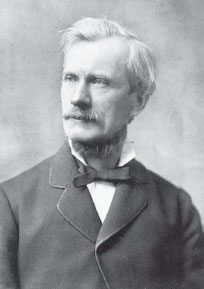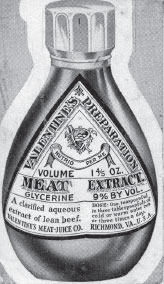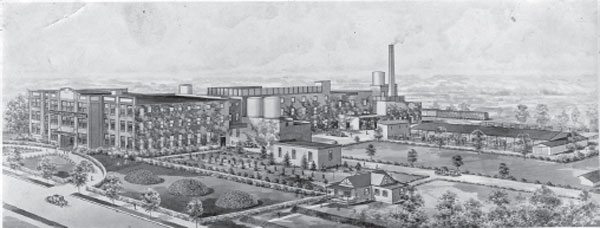
Mann S. Valentine II, the inventor of Valentine’s Meat-Juice and benefactor of the Valentine. The Valentine.
THE MEAT JUICE OF THE MATTER
Valentine’s Meat-Juice
Necessity truly was the mother of invention for Mann S. Valentine II in 1870. His wife, Ann Maria Gray Valentine, mother of their seven sons, lay ill upstairs in their home on North Second Street, wasting away. She had been sick for weeks, and her doctors were unable to do anything more. Her husband decided to take matters into his own hands—and basement. With his wife losing strength, unable to keep any food or medicine down, he relied on his one year of studying chemistry at the College of William and Mary and worked in his cellar on a process to make a potion by “extracting pure juice from meat, concentrate it and preserve it without losing any of its strength-giving properties” in hopes that she could recover. On New Year’s Eve 1870, he succeeded. As she improved noticeably and steadily, his family, neighbors and doctor friends were so amazed that they wanted to try the product themselves. With his dry goods retail experience on tap, his entrepreneurial spirit took hold, and he turned his basement into a business. Valentine’s Meat-Juice changed the family fortunes in more ways than one.122
THE MEDICINE GOES DOWN…AND AROUND
To our ears, meat juice sounds nauseating, the opposite of its purpose, but an 1892 medical text, the N.Y. Medical Times, volume 19, notes Wyeth’s beef juice, Bush’s Bovinine, Murdock’s Liquid Food and Armour’s extract of beef, not to mention Mosquera Beef Cocoa and Beef Jelly. Valentine’s product was “a clarified aqueous extract of lean beef.” His two-ounce bottles contained the concentrated juice of four pounds of lean beef. The recommended dose was one teaspoon diluted in three tablespoons of cold or warm water two or three times a day. That distinctive egg-shaped bottle would need a refill pretty quickly at that rate. “Whenever the stomach from irritability fails to retain either food or medicines, the Meat-Juice may be employed to prepare that organ for their reception.”123
Valentine wasted no time patenting his preparation and, by December 1871, had patents in Great Britain, France, Isle of Man, Ireland, Belgium and, of course, the United States. He opened a manufacturing spot at Tenth and Cary Streets and began advertising in Virginia newspapers that year, marketing “The Germ of Life.” The concoction soon won awards, including a gold medal at the Virginia State Agricultural Society in 1871, the International Exhibition in Philadelphia in 1876 and the Paris Universal Exhibition in 1878, as well as others, for purity and efficiency. The juice had a dark red wine color and was slightly syrupy, hence the instructions to dilute it in water.124
Valentine worked with physicians to improve and test the product and welcomed their testimonials. Dozens of physicians extolled the wonders of it in helping patients recover from yellow fever, seasickness, pulmonary tuberculosis, influenza and many other afflictions. As the marketing materials said, it was the “Food par excellence for a Tired Stomach.” More than one doctor credited it with curing him and/or a member of his family. A doctor in Providence, Rhode Island, wrote, “Valentine’s Meat-Juice was the only nourishment retained by my five-year-old daughter during an attack of Pneumonia. I consider that it saved her life.”125
The company was deft at getting the product out and about, including using family connections in the tobacco business to cultivate sales to Britain. Valentine sent the bottles with missionaries bound for China and Japan, which spread the Meat-Juice gospel as well. It certainly was a coup when King George V’s personal physician, Emperor Yoshita of Japan, the Empress of Russia and China’s great viceroy all gave written testimonials of how it helped their recoveries from serious illness.

Mann S. Valentine II, the inventor of Valentine’s Meat-Juice and benefactor of the Valentine. The Valentine.
IN THE PRESS
Admiring stories appeared in papers across the country. “Not only is the Meat Juice used in case of sickness, but as an article of food in compact form, as a Summer drink instead of liquor, and a beverage at the table of the wealthy, it has grown into great popularity.…In travelling, persons who are liable to suffer from changes of water are simply foolish to be without it. To the consumptive, especially where distressing thirst, nausea and faintness are symptoms, it is the greatest boon ever conferred.” National newspapers reported in 1881 that President James Garfield, after being shot, was served toast and Valentine’s Meat-Juice.126
Not everything in the paper proved good news for the company. Two instances of people using bottles of Meat-Juice to try to hide arsenic poisoning occurred in the Seddon and Maybrick criminal cases in England. The news improved in 1900 when the British Supreme Court of Judicature ruled in the favor of the U.S. company against the Valentine Extract Company operating in England using the Valentine name. Once the imposter company paid its fine, it manufactured Valtine’s Meat Globules. Honest.127
In the early days, the story went that every time Valentine received a large order, he’d head to the bank to get a loan to purchase the cattle he needed to produce the elixir in large amounts. The company expanded and moved several times, building an impressive headquarters at Sixth and Cary Streets. From a young age, his sons worked in the company, and when he died in 1892, eldest son Granville Gray Valentine became president, a post he held for fifty-one years. The elder Valentine’s will included an estate valued at $275,000. A bequest of $50,000, Valentine’s collection of archaeological artifacts and the family home on East Clay Street established the first museum in Richmond, the Valentine, Richmond’s history museum. Some of the family focused on the museum, while others worked in the family business.

The infamous egg-shaped Valentine’s Meat-Juice bottle from an advertisement. Valentine Meat-Juice Records, The Valentine.

The sprawling Meat-Juice plant at 1600 Chamberlayne Avenue—an example of farm to bottle. Valentine Meat-Juice Records, The Valentine.
Soon after Valentine’s death, another tragedy struck when the headquarters on Cary Street went up in flames. The company rebuilt promptly and kept growing. In 1895, as Valentine’s continued to expand production, it purchased forty-six acres in what then was the country at 1600 Chamberlayne Avenue and moved its abattoir from Twenty-Fifth Street and Nine Mile Road to the new site. Cattle arrived at the new location by railcar and fed on fields of hay, alfalfa and corn before it was time to be butchered.
The plant was a marvel of meat, and as the juice production left a lot of solids, side businesses flourished so that not one bit was wasted. Employees, both black and white Richmonders, usually ate pretty well, taking meat home, but hearts, livers, tongues and entrails were sold to butchers. Both shin bones and tibias could be turned into knife handles, and the horns and hooves were sold to button manufacturers. “The head bones go to sugar refineries for use in clarifying sugar; hides to tanners, tripe are sold to sea coast towns for bait.” Dried beef residue was ground for animal and poultry food.128
MODERN MEAT
In 1906, the secretary of agriculture visited the plant and pronounced it “eminently clean, light, airy and sanitary in every respect, and have no criticism to make of this establishment.” He did not ask the cattle for their opinion. When the company outgrew its headquarters downtown in 1920, it moved its entire operation to a modern facility on Chamberlayne, where its abattoir had moved years before.
By 1925, the original product was for sale in Hong Kong, Bombay, Ceylon, South Africa, Australia, Europe, Mexico City and beyond. It had been taken on expeditions to the North and South Poles and the African jungle. No wonder Valentine’s manufactured as many as 600,000 bottles of Meat-Juice a year. There was no limit to its usefulness, according to its own pamphlets: “The time for using the Meat-Juice, besides during illness,—Just before or after meals; on rising in the morning with a feeling of debility; or, on retiring at night and not disposed to sleep”; “A very pleasant and inviting Jelly may be made.…Chicken broth will be improved”; and my favorite, “In the administration of the Meat-Juice by enema, the directions are the same as when taken by the stomach, except that the quantity should be larger.” Indeed.
Valentine’s Meat-Juice was said to be the not-so-secret ingredient in the Bloody Marys at the Commonwealth Club, the exclusive men’s-only spot on Franklin Street where the Valentines were members. Other products were added to the company’s lineup in the 1920s and ’30s, but none ever approached the popularity of the Meat-Juice. Alas, the company ceased production decades ago.
The Valentine Museum has, among its many treasures, one of the finest costume collections in the country, the stunning Neoclassical Valentine-Wickham house and much of Mann II’s brother Edward V. Valentine’s sculpture collection. And of course, there’s the display of Valentine’s Meat-Juice that started the whole enterprise all those years ago. There’s been talk of a rebirth of the product. It could work in tandem with Richmond’s distillery, brewery and cidery craze, for as Mann Valentine V said, “Valentine Meat Juice over ice is just the thing for hangovers.”129